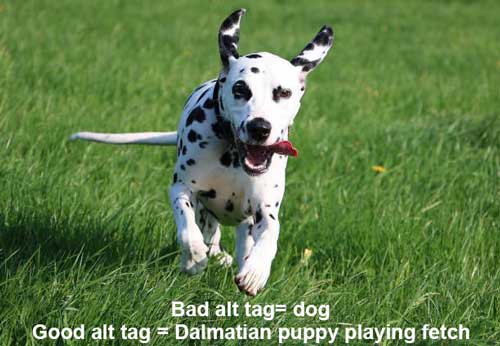Why write image alt text?

Image alt text (or alternative text) are short descriptions (about 125 characters maximum) of images on a web page. You’ll notice them when an image is slow or doesn’t load, they’re the red text describing the image.
Alt text is used by search algorithms when indexing and ranking your page, so they’re great for SEO. Further, the upcoming Mobile-first and Page Experience algorithms will require alt text to improve search rank. Alt text is considered part of image optimization for SEO.
And, the Americans with Disabilities Act (ADA) requires alt text on websites among other rules. Chapter 5, Section 3 C. II. states “If images are used, including photos, graphics, scanned images, or image maps, make sure to include a text equivalent, by adding “alt” tags or long descriptions, for each.” You should read Chapter 5 to identify other ADA website accessibility requirements. Class action lawsuits have been filed against companies over alt tag non-compliance, including Target, Beyonce, Winn-Dixie, Domino’s Pizza, Nike, CVS, Harvard and more. You can use the Google Accessibility Chrome extension to check your page’s accessibility.
This article is intended to outline best practice examples of image alt tags to help you implement these tags properly on your website.
How to write alt tag text
Creating great image alt text for web pages begins with keyword research. Keywords define the content of the page, and selected images support the content and should be focused on the researched keywords. Don’t stuff keywords into alt text or select an image that doesn’t match the keywords or description; that’s considered black hat SEO and websites/pages are penalized with low or no search rank.
When it comes to writing the best alt text we recommend Google’s images best practices guidelines page as a resource (read the page for more image SEO tips). A few tips from that resource page on image selection are:
- Provide good context: Make sure that your visual content is relevant to the topic of the page. We suggest that you display images only where they add original value to the page. We particularly discourage pages where neither the images or the text are original content.
- Optimize placement: Whenever possible, place images near relevant text. When it makes sense, consider placing the most important image near the top of the page.
- Don’t embed important text inside images: Avoid embedding text in images, especially important text elements like page headings and menu items, because not all users can access them (and page translation tools won’t work on images). To ensure maximum accessibility of your content, keep text in HTML, provide alt text for images.
Best practices in writing alt tags include keeping the text less than 125 characters, front loading the keyword, and creating a full, easily understood sentence that includes words describing the action in the photo if there is any.
Here’s Google’s example starting with bad, better and best for writing alt text:

- Bad example (missing alt text): alt=””
- Bad example (keyword stuffing): alt=”puppy dog baby dog pup pups puppies doggies pups litter puppies dog retriever labrador wolfhound setter pointer puppy jack russell terrier puppies dog food cheap dogfood puppy food”
- Better example: alt=”puppy”
- Best example: alt=”Dalmatian puppy playing fetch”
You’ll see that the “best” example:
- Front-loaded the main keyword “Dalmatian puppy”.
- Described the image in less than 125 characters.
- Created a full, easily understood sentence (don’t write cryptic descriptions).
- Included the image action, “playing fetch”.
When writing your alt text remember to do your keyword research first, write the page content, find images matching keywords, keep the descriptions short, accurate and human readable. Also, test your pages for accessibility.
by Andy Hoover of Beasley Direct and Online Marketing, Inc.


